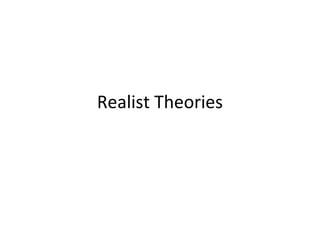
1. realist theories
- 2. Lesson Objectives • Look at how Realist theories differ from other explanations of crime • Introduce Left and Right Realism • Compare and Contrast LR and RR in terms of explanations and solutions to crime • Evaluate Realist explanations
- 3. Last Lesson Recap • What are Neo-Marxist principles based on? • How do they further previous beliefs on crime? • What is Voluntarism and how is it linked to crime? • Explain a fully social theory of deviance?
- 4. Realist Theories • Labelling theory and critical criminology regard crime as socially constructed • Realists see crime as a real problem to be tackled, and not just a social construction created by the control agencies • Argue there has been a significant rise in crime rate – especially street crime. • Are concerned about the widespread fear of crime and impact of crime on its victims • Other theories fail to offer realistic solutions to the problem of crime.
- 5. We can divide realist approaches along political lines… Left Realists Right Realists
- 6. Right Realism • Emerged in the 1970s and 1980s with the political shift to the right (share New Right/ neo-conservative political outlook) Margaret Thatcher Ronald Reagan
- 7. Right Realism These governments favoured rolling back the welfare state together with a strong commitment to law and order. They favoured a ‘zero tolerance’ stance on crime, with increased use of prison (USA-the death penalty)
- 8. The causes of crime • RRs reject the idea that structural and economic factors e.g. poverty and inequality cause crime (unlike which theorists?). They point out that the old tend to be poor yet have a very low crime rate. • Crime is the product of 3 factors: biological differences, Socialisation and the underclass, and rational choice to offend
- 9. AO2: Lily et al (2002) found 1. Biological Differences differences in intelligence accounted for only 3% of • Crime is caused by a the difference in offending combination of biological and social factors • Bio differences between individuals make some people innately more strongly predisposed to commit crime than others e.g. personality traits such as aggressiveness, extroversion, risk taking, low impulse control put some people at greater risk of offending • Hernstein and Murray (1994) main cause of crime is low intelligence which they also see as biologically determined
- 10. 2. Socialisation and the Underclass • Primary Socialisation teaches us self control, we internalise moral values of right and wrong. The best place for this is the nuclear family. • Murray: Nuclear Family being undermined by welfare state • What would they say about the influence of lone parent families on crime?
- 11. 2. Socialisation and the Underclass
- 12. 3. Rational Choice Theory (Clark, 1980) Individuals are rational beings with free will Deciding to commit a crime is a choice based on a rational calculation of the consequences If the rewards appear to outweigh the costs, people will be more likely to offend. Crime rate is high because perceived costs are low e.g. little risk of being caught and lenient punishments AO2: Conflicting views of criminals choosing crime vs. behaviour being due to biology/ socialisation
- 13. • A similar idea to Rational Choice Theory is Felson’s routine activity theory. This states that for crime to occur there must be: 1.A motivated offender, a suitable target (victim or property) and the absence of a ‘capable guardian’ (e.g. policeman/neighbour) 2.Offenders are assumed to act rationally, so the presence of a guardian is likely to deter them (informal guardians more effective)
- 14. Which factor do you find most logical? Which can you apply to: 1.The London Riots 2.A young man robbing a Securicor van 3.Raoul Moat
- 15. So what methods do Right Realists advocate in tackling crime? Summarise Page 94
- 16. Criticisms • Ignores wider structural causes such as poverty • Overstates offenders rationality and how far they make cost-benefit calculations- may explain utilitarian crime but not violent crime • Overemphasises biological factors
- 17. • Preoccupied with petty street crime and ignores corporate crime (more costly and harmful to public) • Advocating a zero tolerance policy gives police free reign to discriminate against ethnic minority youth/homeless et. Crime becomes displaced in other areas • Over emphasises control of disorder, rather than tackling underlying causes of neighbourhood decline e.g. lack of investment
- 18. RR
Notes de l'éditeur
- http://www.youtube.com/watch?v=Xdyth8P3Fu4 RIGHT REALISM http://www.youtube.com/watch?v=r85FMhHWtNk&feature=related RR and LR
- Right realists regard theories such as labelling and critical criminology as too sympathetic to the criminal and too hostile to the forces of law and order. Right realists are less concerned to understand the causes of crime and more concerned to provide what they see as realistic solutions. However, although their main emphasis is on practical crime reduction strategies, they do in fact offer an explanation of the causes of crime. Critical Criminology is a theoretical perspective in criminology which sees crime as a product of oppression.
- http://www.podology.org.uk/#/crime-and-deviance/4538947634 CLIPS 2 AND 3 REALISM
- Concerned with practical solutions to reduce crime. In their views the best way to do is through crime and punishment, rather than rehabilitating offenders or tackling causes such as poverty
- Marxists
- A welfare state is creating welfare dependency and encouraging the growth of an underclass who fail to socialise their children properly Welfare provision has led to the growth of benefit dependent lone parent families, since men no longer need to take responsibility for supporting their families. Absent fathers mean boys lack discipline and an appropriate role model, so they turn to delinquent role models in street gangs and gain status through crime rather than supporting their families
- Informal Guardians- local community groups